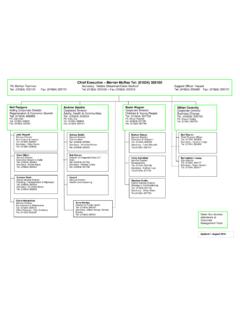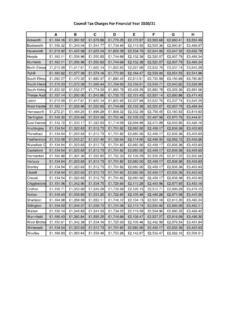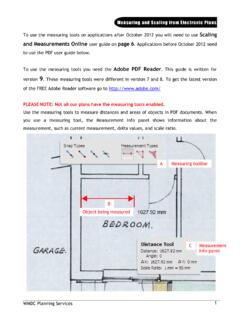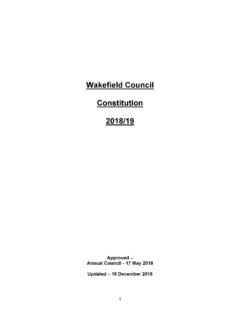Transcription of Wakefield Five Towns
1 Wakefield five Towns Cycleway Network Feasibility StudyTrain on the Pontefract train lineCyclists enjoying the traffic free route along Halfpenny LaneReport prepared for City of Wakefield Metropolitan District CouncilDraft September 2011- Binding Margin - Contents1. Introduction2. Policy context3. Current barriers to walking and cycling in the five 4. Maps with network proposals5. Technical notes6. Estimate of costs and deliverability7. Possible programme of works8. ConclusionReport prepared for City of Wakefield Written & surveyed by: Mike Babbitt and Jake WebsterGraphic design and illustrations prepared by Paul BostonREPORT INTENDED TO BE PRINTED IN FULL COLOUR ON A3 SIZE PAPERAll maps reproduced from the Ordnance Survey material with the permission of Ordnance Survey on behalf of the Controller of Her Majesty s Stationery Office Crown copyright.
2 Unauthorised reproduction infringes Crown copyright and may lead to prosecution or civil makes smarter travel choices possible, desirable and inevitable. We re a leading UK charity enabling people to travel by foot, bike or public transport for more of the journeys we make every work with families, communities, policy-makers and partner organisations so that people are able to choose healthier, cleaner and cheaper journeys, with better places and spaces to move through and live in. It s time we all began making smarter travel areaMetropolitan District 1- Binding Margin - l Wakefield five Towns : Cycling Network Feasibility Study1 IntroductionThe objective of this study is to assess the feasibility of developing a cycle network District. Particular attention will be given to promoting sustainable access to the rail stations. Regular feeder services to Wakefield Kirkgate make Pontefract, Normanton, Knottingley, Featherstone and Streethouse rail stations ideal for commuters wanting sustainable manner.
3 The walking and cycling routes highlighted in this report will help to make the journey from home to the station more accessible and attractive, particularly for novice cyclists. Details of the proposed cycle network in Castleford are available in a separate feasibility report published in north east of the district and historically local employment. According to the LSTF large project initial proposal (June 2011), a large proportion of the population within the travel horizons in Towns where the traditional sources of local employment are in decline make it increasingly important that access to employment opportunities in areas such as Wakefield and Leeds is improved. Future housing growth is planned in the area which provides an exciting opportunity to regenerate disused brown field sites and generate investment in the sustainable transport network.
4 Improvements in the local walking and cycling network are required to open up opportunities for commuters and the wider community to travel in ways which will benefit their health and the five Towns : Cycleway Network Feasibility Study throughout the five Towns area of the Wakefield to make local and regional journeys in a more relied on mining and industry as a source of The Wakefield five Towns area is located to five Towns area have low travel horizons. Low l Wakefield five Towns : Cycling Network Feasibility StudyPage 2- Binding Margin - Importance of promoting healthy living:Regular cyclists typically enjoy a fitness level of a person 10 years younger (British Medical Journal, 1992). Regular activity also helps to reduce the risk of heart disease, burn excess fat and reduce stress. Increasing physical activity is central to the is predicted to cost the UK economy 50 billion annually by 2050 (Department of Health, 2009).
5 2. Policy contextNational Policy: During the development of LTP3 local authorities national transport goals:will improve local connectivity, thereby improving shops and services can be met by local Tackle Climate Change: Contribute to reducing greenhouse gas emissions by providing walking and cycling alternatives to the car. The UK Climate Change Act commits the UK to reductions in CO2 emissions of at least 26% by 2020 and a long term goal of 80% by 2050 compared to 1990 levels. 3. Promote equality of opportunity: The scheme will enhance social inclusion by improving access to employment, services and social networks particularly for low socioeconomic groups and those without access to private Contribute to better safety, security and health: Well used routes are self policing (to an extent), and can improve the perceived safety of an area.
6 The scheme will encourage increased physical activity and improve the health of the local Improve quality of life: Providing attractive walking and cycling routes will provide more opportunities for social interaction, improve access to local facilities and connect the urban landscape with green spaces, all without any negative impact on the Policy: West Yorkshire Local Transport Plan 3 (2011 2026) Wakefield has ambitious plans for housing and jobs growth within its Local Development Framework. Its regeneration and housing growth points Castleford, Pontefract, Knottingley, Featherstone and Normanton. Wakefield city centre is also currently undergoing a programme of regeneration, which will create major opportunities for transport needs to support these plans by making it easier to access local places, services and amenities by sustainable modes.
7 It also needs to support the creation of high-quality, distinctive and safe environments, helping to tackle climate change by reducing congestion.(West Yorkshire Local Transport Plan 2011-26) WYLTP3 aims to encourage walking and cycling by: Providing a network of attractive routes connecting key town centres and local facilities including schools, hospitals, public transport hubs and leisure facilities. Focusing on journeys of up to five miles. Focusing on encouraging uptake from non-regular cyclists. Considering pedestrians and cyclists first in the hierarchy of provision. Reallocation of road space for buses, pedestrians and cyclists as part of demand management strategy. This is also a good way to lock in the benefits of any modal shift that can be achieved. Source: WYLTP 2011-26 Wider considerations (economic, climatic and social)LTP3 highlights that future economic growth within West Yorkshire could be constrained by congestion and overcrowding on the existing transport network.
8 It is estimated that the will increase by 18% over the next 15 years, leading to more trips, road congestion and rail overcrowding (LTP3, 2011). A number of area means that careful planning and investment is required to ensure that the inevitable growth in trips doesn t lead to a damaging amount of congestion and delays. Currently levels of congestion already cost the UK economy billions of pounds every year (DfT, 2009).economically competitive as it could be because the current transport network limits access to job markets, services, housing and leisure opportunities. A report in 2008 by Yorkshire Forward highlighted that areas of Castleford, Pontefract and Knottingley are amongst some of the 10-20% most deprived areas in the country. Despite planned housing growth in these areas, deprivation was not attributed to lack of housing but to a lack of access to education, healthcare and employment.
9 Future development of the local transport network is an reduce CO2 emissions by at least 26% by 2020 and achieve a long term reduction target of 80% by 2050 compared to emissions levels of 1990. Nationally, transport accounts for 26% of CO2 emissions, the majority of which is for personal use (DfT, 2006). Without intervention LTP3 predicts that car ownership and usage will increase as populations become more dispersed. It s predicted that bus operators will continue to increase fares above inflation and reduce the frequency of services, resulting in falling bus patronage and increased 2026, 26% of households in West Yorkshire will not have access to a car, these households are most likely to be amongst the most deprived in the region. Without viable alternatives such as public transport, walking and cycling, increased car reliance is likely to exacerbate accessibility problems in already deprived Supporting Economic Growth: The scheme the chances that local demand for employment, were asked to consider how their plans would number of jobs and workers in west yorkshire to address some of these accessibilityinclude the five Towns area, comprising housing growth points within the five Towns Local Transport Plan 3 Guidance (DfT, 2008)Under the Climate Change Act, the UK must contribute to the delivery of the following 5 key government s battle to curb obesity, which LTP3 highlights that West Yorkshire is not as car reliance.
10 However it is predicted that by Page 3- Binding Margin - l Wakefield five Towns : Cycling Network Feasibility StudyAverage Daily Flows on Selected Roads ( Source : DfT)Road town (s) Vehicles per dayA645 Knottingley, Pontefract Featherstone, Streethouse, Sharlston 15,000 - 19,000A639 Pontefract (west) 20,0003. Current barriers to walking and High traffic volumesHigh traffic volumes do nothing to promote increased levels of walking and cycling. The table below shows the traffic counts on major roads in and around the five Towns . Such high traffic volumes deter many cyclists and justify the need for alternative route provision highlighting the need for alternative route provision:Severanceof different severance issues that do little to encourage or facilitate walking and cycling trips in the local area. Intimidating barriers such as busy roads and rail with limited crossing points can make seemingly short journeys inconvenient, and circuitous.













